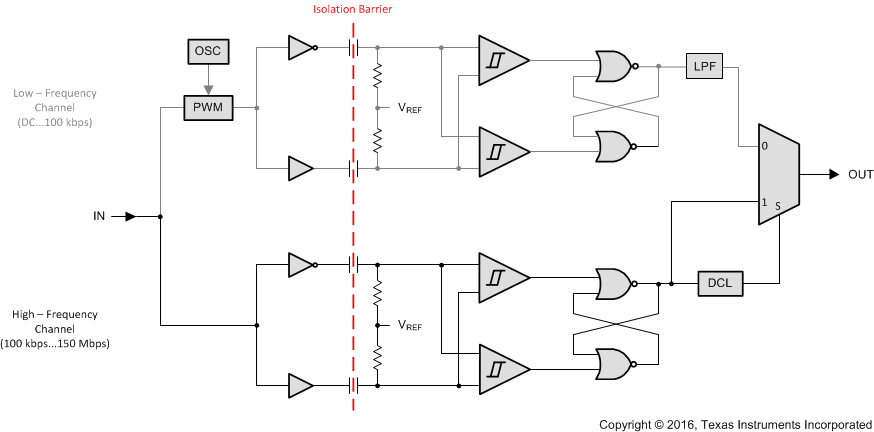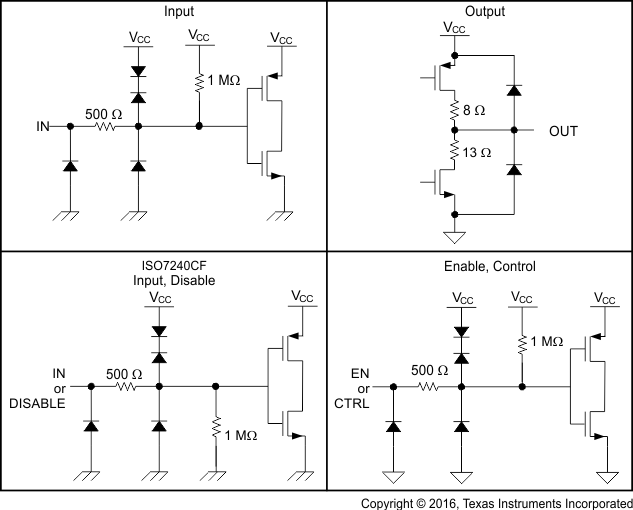SLLS868T September 2007 – April 2017 ISO7240C , ISO7240CF , ISO7240M , ISO7241C , ISO7241M , ISO7242C , ISO7242M
PRODUCTION DATA.
- 1 Features
- 2 Applications
- 3 Description
- 4 Revision History
- 5 Description (Continued)
- 6 Pin Configurations and Functions
-
7 Specifications
- 7.1 Absolute Maximum Ratings
- 7.2 ESD Ratings
- 7.3 Recommended Operating Conditions
- 7.4 Thermal Information
- 7.5 Power Ratings
- 7.6 Insulation Specifications
- 7.7 Safety-Related Certifications
- 7.8 Safety Limiting Values
- 7.9 Electrical Characteristics: VCC1 and VCC2 at 5-V Operation
- 7.10 Supply Current Characteristics: VCC1 and VCC2 at 5-V Operation
- 7.11 Electrical Characteristics: VCC1 at 5-V, VCC2 at 3.3-V Operation
- 7.12 Supply Current Characteristics: VCC1 at 5-V, VCC2 at 3.3-V Operation
- 7.13 Electrical Characteristics: VCC1 at 3.3-V, VCC2 at 5-V Operation
- 7.14 Supply Current Characteristics: VCC1 at 3.3-V, VCC2 at 5-V Operation
- 7.15 Electrical Characteristics: VCC1 and VCC2 at 3.3 V Operation
- 7.16 Supply Current Characteristics: VCC1 and VCC2 at 3.3 V Operation
- 7.17 Switching Characteristics: VCC1 and VCC2 at 5-V Operation
- 7.18 Switching Characteristics: VCC1 at 5-V, VCC2 at 3.3-V Operation
- 7.19 Switching Characteristics: VCC1 at 3.3-V and VCC2 at 5-V Operation
- 7.20 Switching Characteristics: VCC1 and VCC2 at 3.3-V Operation
- 7.21 Insulation Characteristics Curves
- 7.22 Typical Characteristics
- 8 Parameter Measurement Information
- 9 Detailed Description
- 10Application and Implementation
- 11Power Supply Recommendations
- 12Layout
- 13Device and Documentation Support
- 14Mechanical, Packaging, and Orderable Information
9 Detailed Description
9.1 Overview
The isolator in Figure 17 is based on a capacitive isolation-barrier technique. The I/O channel of the device consists of two internal data channels, a high-frequency channel (HF) with a bandwidth from 100 kbps up to 150 Mbps, and a low-frequency channel (LF) covering the range from 100 kbps down to DC. In principle, a single-ended input signal entering the HF-channel is split into a differential signal through the inverter gate at the input. The following capacitor-resistor networks differentiate the signal into transients, which then are converted into differential pulses by two comparators. The comparator outputs drive a NOR-gate flip-flop the output of which feeds an output multiplexer. A decision logic (DCL) at the driving output of the flip-flop measures the durations between signal transients. If the duration between two consecutive transients exceeds a certain time limit, as in the case of a low-frequency signal, the DCL forces the output-multiplexer to switch from the high- to the low-frequency channel.
Because low-frequency input signals require the internal capacitors to assume prohibitively large values, these signals are pulse-width modulated (PWM) with the carrier frequency of an internal oscillator, thus creating a sufficiently high frequency signal, capable of passing the capacitive barrier. As the input is modulated, a low-pass filter (LPF) is required to remove the high-frequency carrier from the actual data before passing it on to the output multiplexer.
9.2 Functional Block Diagram
 Figure 17. Conceptual Block Diagram of a Digital Capacitive Isolator
Figure 17. Conceptual Block Diagram of a Digital Capacitive Isolator
9.3 Feature Description
The ISO724xx family of devices is available in multiple channel configurations and default output-state options to enable wide variety of application uses. Table 1 lists these device features.
Table 1. Device Features
| PRODUCT | SIGNALING RATE |
INPUT THRESHOLD |
CHANNEL CONFIGURATION |
|---|---|---|---|
| ISO7240C | 25 Mbps | ~1.5 V (TTL) | 4/0 |
| ISO7240CF | 25 Mbps | ~1.5 V (TTL) | |
| ISO7240M | 150 Mbps | VCC/ 2 (CMOS) | |
| ISO7241C | 25 Mbps | ~1.5 V (TTL) | 3/1 |
| ISO7241M | 150 Mbps | VCC/ 2 (CMOS) | |
| ISO7242C | 25 Mbps | ~1.5 V (TTL) | 2/2 |
| ISO7242M | 150 Mbps | VCC/ 2 (CMOS) |
9.4 Device Functional Modes
Table 2 lists the ISO724xx functional modes. Table 3 lists the ISO7240CF functional modes.
Table 2. Device Function Table ISO724x(1)
| INPUT VCC | OUTPUT VCC | INPUT (IN) |
OUTPUT ENABLE (EN) |
OUTPUT (OUT) |
|---|---|---|---|---|
| PU | PU | H | H or Open | H |
| L | H or Open | L | ||
| X | L | Z | ||
| Open | H or Open | H | ||
| PD | PU | X | H or Open | H |
| PD | PU | X | L | Z |
| X | PD | X | X | Undetermined |
Table 3. ISO7240CF Functions Table(1)
| VCC1 | VCC2 | DATA INPUT (IN) |
DISABLE INPUT (DISABLE) |
FAILSAFE CONTROL (CTRL) |
DATA OUTPUT (OUT) |
|---|---|---|---|---|---|
| PU | PU | H | L or Open | X | H |
| PU | PU | L | L or Open | X | L |
| X | PU | X | H | H or Open | H |
| X | PU | X | H | L | L |
| PD | PU | X | X | H or Open | H |
| PD | PU | X | X | L | L |
| X | PD | X | X | X | Undetermined |
